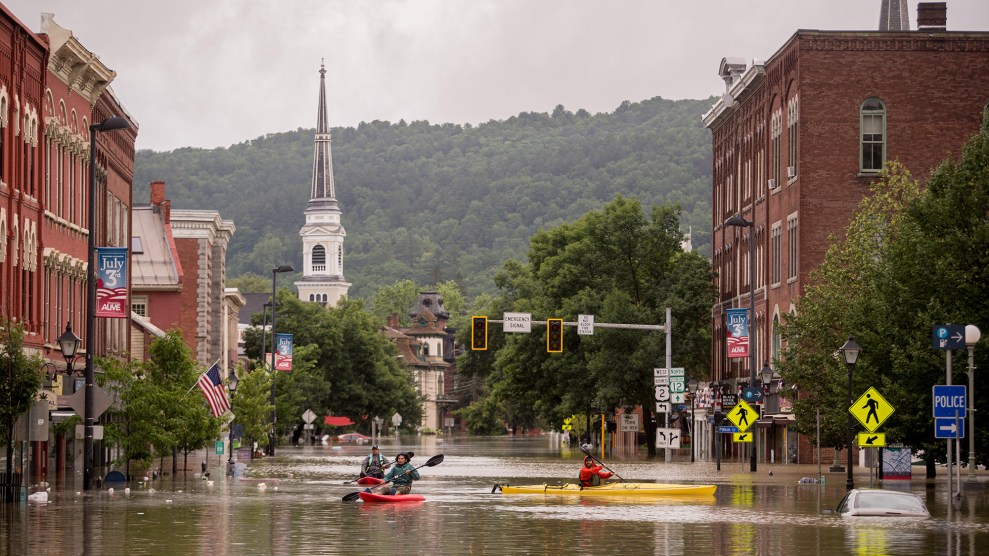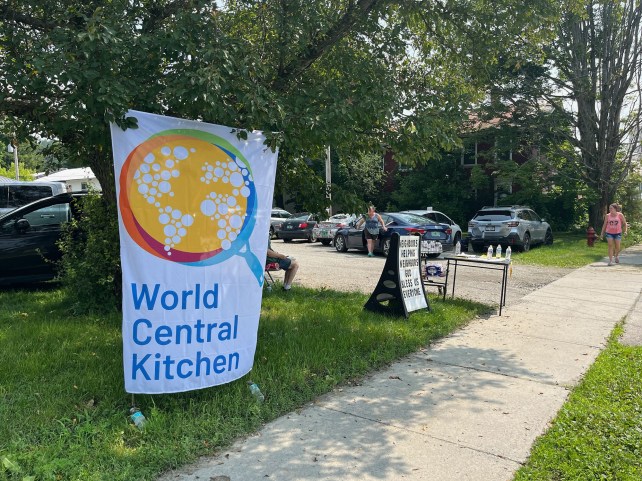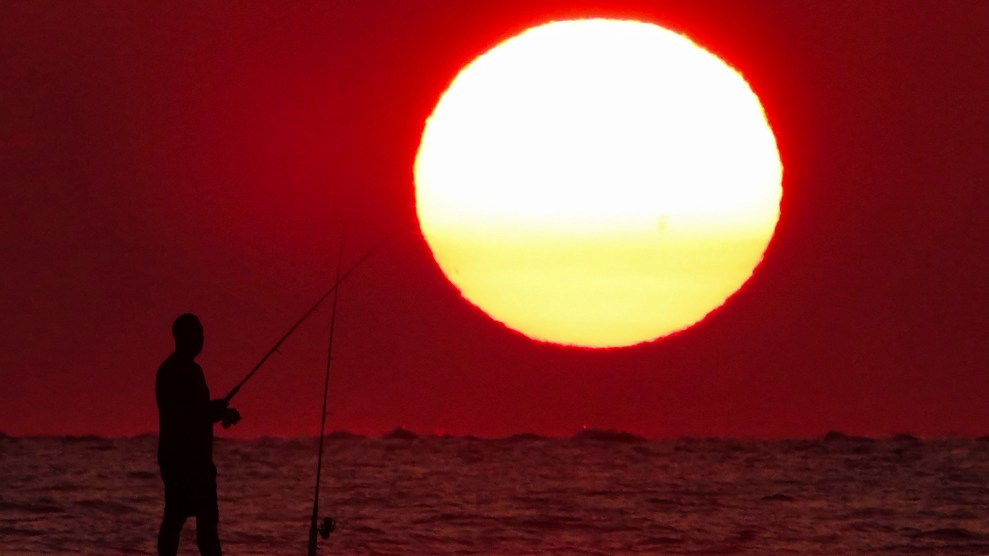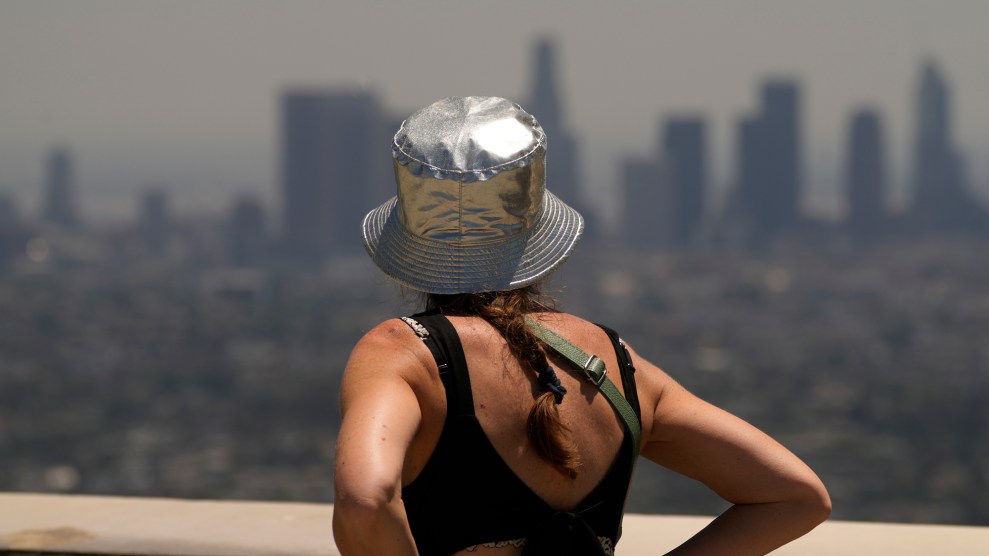
Flooding in downtown Montpelier, Vermont John Tully/The Washington Post/Getty
It’s raining, again. Days after Vermont was inundated, the skies just can’t let up. After enjoying brief periods of dryish weather, the clouds rolled in and the rain has started anew.
Last week, Vermont became the latest casualty of the dire weather that has afflicted many parts of the country this summer. We’ve all read stories about the extreme heat in Texas and Arizona that strained power grids and ravaged communities. Heat wasn’t our problem, catastrophic flooding was. Areas around Vermont received up to 8 or 9 inches of rain in only a day and a half. But this took place after a few weeks of intermittent storms that had thoroughly soaked the ground. Multiple inches of rain, saturated soils, and mountainous terrain created perfect conditions for flooding. And boy, did it ever flood.
In a recent press conference, Governor Phil Scott noted, “The flooding we have seen is historic and catastrophic, surpassing levels seen during Tropical Storm Irene.” He was referring to the massive 2011 hurricane that hit the Caribbean and the East Coast of the US. Even though the storm had degraded into a tropical storm once it reached Vermont, it still killed six people, left 20,000 acres under water, and inflicted enormous damage on over 500 miles of state highways and 200 bridges. This year, few areas of the state were spared, and President Biden approved the governor’s request to declare a major disaster for all of Vermont’s counties.
I’ve been coming to Vermont since I was a child and lived here for a bit when I worked for the Center for Northern Studies—an interdisciplinary academic center focused on the circumpolar north. My husband and I still come up here to the northern Vermont town of Jeffersonville—about 45 minutes east of Burlington—and stay in the home that my parents built in the mid-1970s. My sister lives nearby, and our kids sought refuge here during Covid. Vermont was always my haven, a security blanket that I could wrap around me when the rest of the world just felt like too much. The expanse of forests, the burble of streams, and the independence and self-sufficiency of the people was a true sanctuary, a protected place, distant from the chaos of the world.
Now, the wrapping of that security blanket has loosened a bit. As an environmental scientist and writer, I studied and wrote about the environmental issues plaguing the Chesapeake Bay for a few decades. Although there has been some progress, I’ve always felt that the main problem was the huge population of people within the 64,000 square-mile Chesapeake watershed that includes Baltimore and Washington, DC. When millions of people are flushing their toilets, driving their cars, and fertilizing their lawns, the cumulative effect can prove difficult to diminish.
Vermont was never like that. Except for the small cities, much of the state consists of far-flung villages and rural landscapes. The Green Mountain State is 80 percent forested, while much of the rest of its land is in agricultural production. The population hovers just under 650,000 people; in comparison, New York City’s is around 8.5 million.
I know that rivers are ephemeral. Jeffersonville sits on the banks of the Lamoille River that runs through northern Vermont into Lake Champlain. Rivers are meant to change course, flood, run high and run low. Even once-in-a-lifetime floods are supposed to occur, well, about once in a lifetime. The last time there was a flood close to this magnitude was, as Governor Scott said, Hurricane Irene a mere 12 years ago. Hardly a lifetime.
Johnson, a village of about 1,400 people about 10 miles from our place, is home to Vermont State University and the Vermont Studio Center. Once the road opened back up, we drove into Johnson. The waters of the Lamoille River had risen almost to the ceiling of the beloved local independent grocery store. A couple of days later, a bulldozer was inside the store shoveling the ruined remains out to the curb. It’s unclear whether the store will rebuild, which means that residents of the community would need to drive up to 8 miles to do their grocery shopping.
Making matters significantly worse was the complete destruction of the town’s wastewater treatment plant. Until a temporary fix is found, wastewater will discharge directly into the river. That’s more than just yuck; it’s a serious health hazard because all of the town’s effluent is now flowing into the Lamoille River—a situation more common in poor and developing countries than in the US. But Johnson isn’t unique; many other Vermont towns are dealing with the same problem.
Buildings that appear unscathed at first, turn out not to be at all. Jenna’s Coffee House is a business that affords work opportunities to those in recovery from opioid abuse and have completed a recovery program. and are just getting back on their feet. The café provides jobs for those who have completed a recovery program. Some of the workers live on the second floor of the building, making for a hard-to-beat commute. Open for breakfast and lunch, a few days after the storm, Jenna’s customers were getting served. The quiet on the first floor, however, belied the chaos underground where 9 feet of floodwater still churned through the basement. When I stopped in for a green tea Danish, Senator Bernie Sanders’ (I-Vermont) video team was interviewing the barista to highlight the flood status and the government’s response.

World Central Kitchen set up in Vermont to help flooding victims
Courtesy NIna Fisher
So dire is the situation in Johnson that World Central Kitchen, the brainchild of José Andrés and best known for its critical work in crisis areas all over the world, including in the Ukrainian war zone, has moved in to supply water and meals for those in need. Vermonters who may have recently contributed to WCK to support its work overseas may now find themselves the recipients of aid from the very same organization.
My husband and I had signed up to walk with Bernie Sanders along the Lamoille Valley Rail Trail to celebrate its long-awaited completion on the Saturday after the storm. This biking, running, cross-country skiing trail spans 93 miles across the state, connecting 18 villages. The railroad using the line went defunct in the mid-1990s and a decade later planners started repurposing the trail for recreational use. Proponents pitched the trail as an economic boon to the small towns along its path, with hikers, bikers, and runners likely generating business for the villages and their businesses. After years of work, the final construction touches wrapped up just weeks ago.
Then the storm hit.
One heavy-duty bridge in Hardwick—a town 20 miles upstream from Johnson—collapsed and its frame now cants upward at a steep angle with the western end sitting in the river. Portions of the trail have severe erosional gashes, and other sections are completely washed out. The celebratory hike and official trail opening with Bernie Sanders and the governor we had planned to attend was canceled. The two men were going to meet up while the governor was biking the 93-mile length of the trail—in a single day! But now, the Vermont Agency of Transportation has closed the entire trail for an unspecified length of time to assess damage and make repairs. In just moments, the anticipated celebration was replaced by shock, dismay, and sadness. And then there were the years of work and the more than $31.5 million project cost, literally down the drain.
Jeffersonville, another small village in northwestern Vermont where my family home fortuitously sits on a hill, has a story that mimics that of many towns around the state. An aerial drone view of the village taken just after the storm shows the traffic circle perched as an island while all the roads leading to it sit underwater. The field where the weekly farmers’ market takes place was completely inundated. The iconic local covered bridge lost half its siding. Somehow, the popular food truck, the Burger Barn, was up and running before many other businesses had even fully assessed the damage.
Three miles away, the village of Cambridge has a small general store. Such stores are often the lifeblood of these towns and this one is no different. Walking in, I found a man slouching against the counter, casually popping French fries into his mouth. The power was out. The produce shelves were empty although canned goods were plentiful. Once more, what appeared to be a somewhat functional store had 9 feet of water in its basement. At that moment, popping fries seemed like a reasonable response.
I could ramble on, but the simple fact is that the pace of disasters that climate change has kicked into gear is likely not replicated in geologic history (with the possible exception of the asteroid hitting the earth and causing global extinctions). But just to be clear: it’s us; we’re doing this; and it’s difficult to fathom how we’re going to stop it or even slow it down.
I once considered Vermont to be my harbor, the safe place largely unaffected by the rest of the country’s environmental problems. Even though it’s now obvious, I suppose, that the effects of climate change know no boundaries. My blanket is unraveling.
Here in Vermont, the forecast is for more rain.













